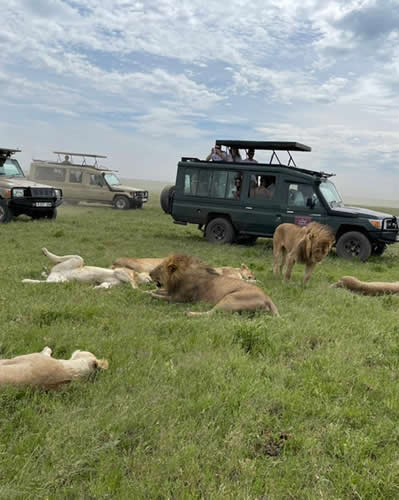Our Tanzania Safari prices range from Camping tours, lodge safaris, bush and beach relaxing holidays and Kilimanjaro climbing tours and luxury Tanzania safaris. On your Tanzania safari, we take you to explore the Ngorongoro crater and into the Northern Tanzania safari parks as well as the Southern Tanzania safari circuit which will offer tourists excellent wildlife viewing.
Wild Uganda Safaris patterns to offers action packed Tanzania safari packages with a combination of other East African country tours.

The cost of Tanzania safaris we offer range from Budget, deluxe to luxury accommodation facilities to suite the needs of the clients to enable travelers to enjoy the unique wildlife, nature, rich cultural experiences and the Serengeti balloon safaris.
Top Tours in Tanzania
3 Days Ngorongoro crater and Tarangire NP
3 Days Serengeti Safari
4 Days Serengeti and Ngorongoro Safari
5 Days Tanzania Safari
7 Days Kenya and Tanzania Safari
7 Days Private Tanzania Safari
8 Days Tanzania Kenya Safari
9 Days Gorilla Trekking and Tanzania Safari
10 Days Uganda Gorillas and Tanzania
10 Days Rwanda Gorillas and Tanzania
12 Days Uganda, Kenya, Tanzania
Best time to visit Tanzania for safari
If you are visiting Tanzania for the first time and you want to experience the best of wildlife, the best time to get there is during the dry season. The main dry months of the year run from June, July, August, September to October –the most preferred months of the year to witness the Great Migration experience. These months are also favorable for the big five game safaris or beach holidays in the coastline/Zanzibar.
Visitors interested in secluded experiences, the most ideal months are October, November to December –the short rainy season. The long rainy months fall from April, May –the months when the ground can be muddy or slippery due to heavy rains.
Visiting Tanzania around January
Around January, most parts of Tanzania experience fairly dry and hot weather conditions. Temperatures begin rising after the short rains in November and December. Short rain showers may start in the night and if you want to witness the wildebeest calving experience then January is the best month of the year to travel to Serengeti National Park.
February –temperatures continue to rise and migration still concentrates in the Ndutu plains. This is also one of the optimal months for conquering the great heights of Kilimanjaro Volcano or visit Zanzibar for a memorable beach vacation.
The wildebeest begin moving towards the Grumeti River around March and temperatures can be hot. This is perfect month to start your trekking, beach trips and safaris in the parks. But towards the end of it, heavy rains can be experienced.
April – May months is known as the wettest months of the year. The rains usually fall in the afternoon and come with thundershowers. The highest humidity is recorded in the Western and Southern parks, but preferable for visitors interested in budget accommodation. It is during this period when most lodges or accommodation facilities cut down on their rates being the off months of the year.
June – August –great wildlife sightings, especially the big game and wildebeest migration are perfectly experienced from June to August. They fall under the peak months of the year.
From November to December –November is among the most underrated months of the year when it comes to Tanzania safaris. November is the best of month of the year to experience the most of the off-the-beaten track destinations in Tanzania. In December, short rains may occur and is also ideal for birding excursions, especially if you are targeting to identify migratory avifaunal species.
Wildlife to see in Tanzania
Tanzania holds diversity of wildlife from small to large mammal species, reptiles, and more. Over 16 national parks exist in Tanzania, and more than 20% of the large mammal species in Africa survive in the various habitats in the country’s habitats.
The big 5 game –leopards, rhinos, elephants, lions, and buffaloes. These can be spotted on Tanzania safari in Serengeti National Park, Selous Game Reserve, Ngorongoro Crater Conservation and Tarangire National Park.
The big cats and predators –Tanzania is most popular for its amazing predators and big cats including leopards, lions, caracals, serval, elusive golden cats, and more. If you are interested in cheetah encounters, the best places to explore include Northern tourism parks exclusive of Lake Manyara National Park. Great sightings of cheetah are experienced at Ruaha National Park.
Different antelope families can be excellently spotted in parks like Ngorongoro, Serengeti National Park. The antelope families to interact with include kongoni, topis, hartebeest, Kudus, impalas, sable mongoose, roan antelope and more.
The great migration experience –to explore the Serengeti-Maasai Mara ecosystem in search for wildebeest, the ideal period is around June to September. For enthusiastic birders, there is a chance to identify diversity of Tanzania’s bird species. A total of over 1100 species of birds exist in Tanzania and include the bee-eaters, kingfishers, jacanas, falcons, and more.
Primates –the memorable primate encounters can be experienced around Gombe National Park and Mahale Mountains. The various primate species in Tanzania to be spotted include olive baboons, chimpanzees, vervet monkeys, patas monkeys, bush babies, colobus monkeys, and more.
Marine life –there are different marine species to be explored along the coastline. These exist along the Zanzibar archipelago, and they are bred at the Saadani National Park, Pemba, and Mnemba Islands.
What to pack for a safari in Tanzania
The list of essentials to include into your packing list include first aid kit, medication, insect repellents, camera, friendly clothes, comfortable shoes, safari hat, and more.


